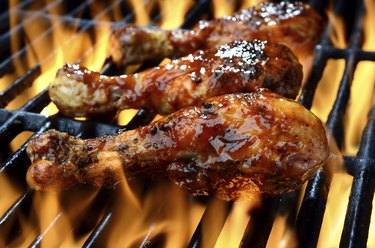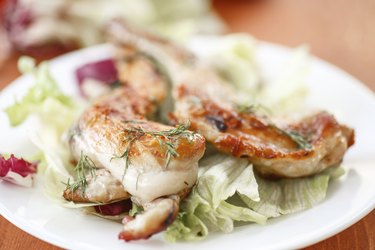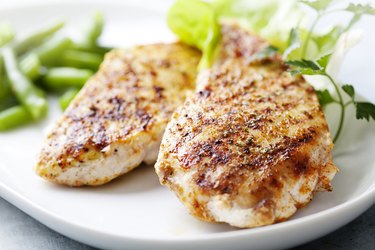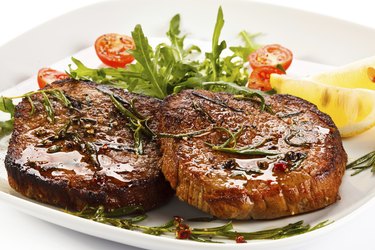
Roasting and grilling are closely related cooking methods, each using indirect dry heat to cook the food. Both methods are widely used by health-conscious diners because they render fat from foods as they cook and don't require any to be added. Despite these similarities, there are profound differences between the two methods of cooking.
Indirect Dry Heat
Video of the Day

Professional cooks categorize all cooking methods as being either "dry-heat" or "wet-heat" methods. Dry-heat cooking, as the name indicates, takes place in the absence of liquid. Wet-heat cooking requires a water-based liquid or steam. Dry-heat cooking methods can themselves be categorized in several ways. One is to divide them into direct and indirect heating methods. Pan-searing or sauteing constitutes direct heat because the food is in contact with the cooking surface. Roasting and grilling are indirect heat because the heat is conducted to your food through the air.
Video of the Day
Roasting

Traditionally, roasting meant cooking foods -- usually meats -- in front of or over a fire or bed of coals. In practice, as enclosed ranges came into use and open hearths faded, the term slowly came to encompass meats cooked in the oven as well. The oven is essentially just an insulated box, and the air inside the oven is raised to a preset temperature in order to convey heat to the food. Starting or finishing a roast, at temperatures up to 475 Fahrenheit, will brown it nearly as well as as grilling or broiling.
Grilling

Grilling takes place over a gas or charcoal flame, giving it more in common with traditional open-fire roasting than the modern oven variety. In this instance, the food is placed on a grill situated a few inches over the gas jet or coals, where the intense heat cooks foods quickly. Grilling is usually considered to be a healthy and low-fat cooking method because it renders out a food's internal fats during the cooking process.
Comparison

Both broiling and roasting have strengths and weaknesses. Grilling produces richly browned surfaces, attractive grill marks and food with lower fat content than it had to begin with. However, the intensity of the heat used makes it best suited to thin cuts such as steaks, chops and chicken quarters. Roasting can also produce this level of browning, though not as quickly. Roasting can also reduce fat content, especially if the roasting pan has a rack. Roasting takes place at a slower pace, so it's possible to cook larger cuts without their being burnt on the outside or raw in the middle.